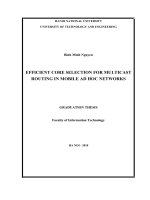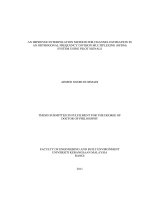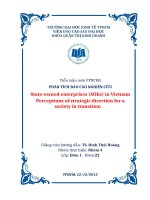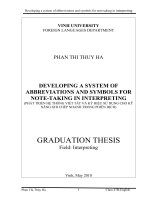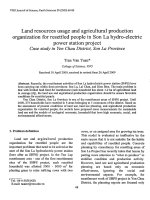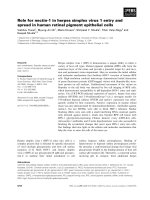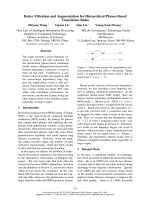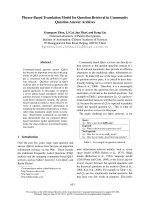data augmentation for latent variables in marketing
Bạn đang xem bản rút gọn của tài liệu. Xem và tải ngay bản đầy đủ của tài liệu tại đây (2 MB, 233 trang )
i
DATA AUGMENTATION FOR LATENT VARIABLES IN MARKETING
DISSERTATION
Presented in Partial Fulfillment of Requirements for
the Degree Doctor of Philosophy in the Graduate
School of The Ohio State University
By
Ling-Jing Kao, B.A., M.S.
* * * * *
The Ohio State University
2006
Dissertation Committee:
Dr. Greg M. Allenby, Adviser
Dr. H. Rao Unnava
Dr. Thomas Otter
Approved by
___________________________________
Adviser
Business Administration Graduate Program
ii
ii
ABSTRACT
Latent variable models are an important aspect of consumer research whenever the
determinants of behavior are an important aspect of study. The purpose of this thesis is
to develop a new method of error augmentation to deal with latent variable models of
heterogeneous, non-linear consumer behavior for two issues commonly encountered in
marketing. The first issue relates to a consumer’s purchase decision driven by a time-
varying latent behavior process. The second issue relates to consumer preferences
affected by multiple unobserved factors.
This thesis comprises three essays. The first issue is addressed in the first and the
second essays, and the second issue is addressed in the third essay. The new method of
error augmentation is applied to estimate models proposed in this thesis. The new method
of error augmentation is needed because, in the proposed models, the observed discrete
choices do not have a direct correspondence to the errors. The proposed models would be
difficult to estimate without the new approach.
The first essay develops a new method of error augmentation for state-space models
of economic behavior where the observed behavior is related to a latent variable whose
temporal variation is described by a state equation. The proposed state-space model is
applied to analyze a consumer’s purchase and resignation decisions in a membership club.
iii
The result indicates that increasing inter-arrival time between shipments can lead to
longer customer longevity and greater sales.
The second essay investigates an alternative method of modeling customer inter-
purchase times. A state-space model is proposed to investigate the possibility to model
inter-purchase times as an independent variable. The results indicate that the proposed
state-space model can accurately describe customer behavior when the specification of
the state equation is plausible for the data.
In the third essay, a demand model is developed to address three issues in choice
modeling. The first issue relates to the effects of multiple treatments for data collected in
a pre-post study. The second issue relates to a marketing action of line extension that is
widely adopted in marketing practice. The last issue relates to consumer decisions of
brand-pack and no-choice for consumer packaged goods at the level of stock-keeping unit.
Data from a leading consumer packaged goods company are used to study changes
in consumer preferences and sensitivities in a simulated shopping environment. The
results indicate that consumers’ reactions to media are very heterogeneous. Media can
make some consumers have extreme preferences, and make preferences of some
consumers become more homogeneous.
This thesis contributes marketing literature by developing a new method of error
augmentation for latent variable models that cannot be estimated by standard approaches.
The new method of error augmentation is illustrated by three different marketing
applications in this thesis. The state-space model proposed in the first and the second
essays can be extended to study consumer learning or consumer searching behavior. The
iv
demand model proposed in the third essay can be extended to study consumer preference
changes in multiple stages.
v
Dedicated to my parents Tsung-Ching Kao and Yu-Hsiu Hsu
vi
ACKNOWLEDGMENTS
I wish to express sincere thanks to my advisor, Dr. Greg M. Allenby, for the time
and effort he put into my doctoral education. You are an outstanding scholar. You have
been a responsible facilitator, gatekeeper, and protector in my graduate study as well as a
wonderful friend in my life. I have learned tremendously from you.
I also want to thank you for the challenges and frustrations you give to me in
research. These challenges and frustrations make me think a lot about my life and myself.
It makes me be tougher and stronger in the road of pursuing my dream. Without these
challenges and frustrations, I will still be a child spoiled by people around me. This
training process of doctoral education has installed me a dedication to rigor in research.
Without your mentoring, I could not have succeeded in my doctoral journey.
My appreciation is also extended to the other members of my dissertation committee,
Dr. H. Rao Unnava and Dr. Thomas Otter. I want to thank them for providing guidance
and support during my dissertation research and during my time at Ohio State. I thank
the other marketing faculty at Ohio State for their enduring support to my doctoral
education. I want to thank current and past Ph.D. students particularly Jaehwan Kim,
Yancy Edwards, Tim Gilbrid, Sandeep Chandukala, and Jeff Dotson for their support and
friendship.
vii
I also want to thank Cindy Coykendale and Lisa Gang for providing invaluable help
on all administrative details. I want to thank Tim Renken and June Hahn for providing
data for my dissertation. My dissertation cannot be completed on time without the help
form Curtis Smith in the department of computing and communication services. I want to
thank you for setting up R environment in Unix servers for me.
I could not have started or completed my doctoral studied without the support of my
family. My parents Tsung-Ching Kao and Yu-Hsiu Hsu always stand by for me with
strong faith while I pursued my dreams and for being patient with, believing in, and
walking with me. I also appreciate my brothers and sister, Yu-Sui, Kuo-Ting, and Hsin-
Chih, for their overwhelming concern and encouragement.
Finally, I would like to give my special thank to Dr. Chih-Chou Chiu in National
Taipei University of Technology for his invaluable friendship and encouragement along
the way. I thank you to stand by for me and listen to me while I was in depression. You
have tremendous influence on my decision of pursuing doctoral degree. Your humanity
and personality have inspired me to contribute myself to our society and people in the
world.
viii
VITA
November 29, 1974 Born – Taipei, Taiwan
1997 B. A., Business Administration
Fu-Jen Catholic University, Taipei, Taiwan
2001 M. S., Statistics
Texas A&M University, College Station, TX,
USA
2001-present Graduate Teaching and Research Associate,
The Ohio State University
FIELDS OF STUDY
Major Field: Business Administration
Specialization: Marketing
ix
TABLE OF CONTENTS
Page
Abstract ii
Dedication v
Acknowledgements vi
Vita viii
List of Tables xi
List of Figures xii
Chapters:
1. Introduction 1
2. Data augmentation and latent variable models 6
3. Essay 1: Estimating State-Space Models of Economic Behavior: A Hierarchical
Bayes Approach 12
3.1 Introduction 12
3.2 State-space models for economic behavior 14
3.2.1 Model estimation 17
3.2.2 Model identification 24
3.3.3 Simulation study 26
3.3 Direct marketing application 27
3.4 Estimation results 30
3.5 Discussion 32
3.6 Conclusion remarks 33
4. Essay 2: A State-Space Model of Purchase Timing for Direct Marketing 46
4.1 Introduction 46
4.2 Model development 48
4.3 Data and model specification 51
4.3.1 State-space model specification 52
4.3.2 Inter-purchase time model specification 53
4.4 Parameter estimates and predictive results 54
4.5 Discussion 56
5. Essay 3: Modeling Media Interactions and Preference Change in Panel Data 64
5.1 Introduction 64
x
5.2 Literature review 70
5.2.1 Preference change and consumer heterogeneity 70
5.2.2 Advertising and media effects 72
5.2.3 Discrete quantity 75
5.3 Model development 80
5.3.1 Treatment effect 84
5.3.2 Generating latent utility 88
5.3.3 Data augmentation for error terms 91
5.4 Empirical application 92
5.4.1 Data of consumer packaged goods 92
5.4.2 Proposed models for the empirical study 95
5.4.3 Location identification of proposed models 98
5.5 Results 100
5.5.1 Model comparison 100
5.5.2 Coefficient estimates 102
5.6 Conclusions 109
6. Conclusions 152
Appendices 156
Appendix A: MCMC Estimation for Essay1 156
Appendix B: MCMC Estimation for Essay 2 166
Appendix C: MCMC Estimation for Essay 3 175
List of references 215
xi
LIST OF TABLES
Table Page
3.1 Parameter estimates 45
4.1 Parameter estimates (posterior standard deviations) 63
5.1 Levels of independent variables 134
5.2 Descriptive statistics 135
5.3 Brand switching matrices 136
5.4 The frequency of media exposures 138
5.5 Sticker 139
5.6 Number of respondents who do not select media of each brand 140
5.7 Model comparison 141
5.8 Posterior estimates of
β
142
5.9 Posterior estimates of V
β
143
5.10 Posterior estimates of
γ
144
5.11 Posterior estimates of V
γ
146
5.12 Posterior estimates of
θ
148
5.13 Posterior estimates of V
θ
150
xii
LIST OF FIGURES
Figure Page
3.1 Markov chain realizations of
α
: (a) New algorithm; (b) Standard algorithm 35
3.2 Identification analysis for latent inventory (s) and effect size (
β
) 36
3.3 Markov chain realizations of model parameters for simulation study 37
3.4 Descriptive statistics 38
3.5 Posterior distribution of customer and item effects 39
3.6 Acceptance rates versus items effects (
α
k
) 40
3.7 Posterior distribution of autocorrelation coefficients (
φ
j
) 41
3.8 Customer longevity (T
j
) versus autocorrelation coefficients (
φ
j
) 42
3.9 Posterior distribution of initial state (s
0
) 43
3.10 Expected demand for offering inter-arrival times 44
4.1 Comparison between standard inter-purchase time model and
state-space model 58
4.2 Heterogeneity distribution of state-space model parameters 60
4.3 Heterogeneity distribution of inter-purchase time model parameters 61
4.4 Comparison of model forecasts 62
5.1 Box plots for the posterior mean of brand preference of multiplicative Model 111
5.2 Scatter plots for pre-post posterior mean of brand intercept of
multiplicative model 112
xiii
5.3 Scatter plots for posttest brand intercept of Brand A+ and pretest brand
preference intercept of established brands 113
5.4 Scatter plots for posttest brand intercept of Brand A+ and posttest brand
intercept of established brands 114
5.5 Components of consumer preferences intercept of Brand A+ (
01,h
β
) 115
5.6 Histogram for the difference of pre-post posterior mean of consumer
sensitivities to marketing merchandising variables of multiplicative model 116
5.7 Histogram for the difference of pre-post posterior mean of consumer
preferences to product attributes 1,2 and 3 of multiplicative model 117
5.8 Histogram for the difference of pre-post posterior mean of consumer
preferences to product attributes 4 of multiplicative model 118
5.9 Histogram for the difference of pre-post posterior mean of consumer preference
to quantity (β
x,h
) and the outside goods (β
*
T,h
)of multiplicative model 119
5.10 Box plots for the posterior mean of γ
h
for all information sources of Brand A+ 120
5.11 Media effects on the intercept of Brand A 121
5.12 Media effects on the intercept of Brand B 123
5.13 Media effects on the intercept of Brand D 125
5.14 Aggregate media effects (
,zh h
M
θ
) 127
5.15 Media effects on consumer preferences to product attribute 1 128
5.16 Media effects on consumer preferences to ln(x+1) 130
5.17 Media effects on consumer sensitivities to ln(
T-p(x)) 132
1
CHAPTER 1
INTRODUCTION
Marketing data reflect latent behavioral processes that are heterogeneous and non-
linear. Consumers are often thought to make choices according to principles of utility
maximization once they attend to marketing stimuli. However, factors that influence
behavior are often not observed by the researcher, and the factors that influence the
engagement of attention are not well represented by a linear compensatory model. For
example, household inventories non-linearly affect brand preference and purchase timing
in the presence of diminishing marginal returns. When inventories are not observed,
complications arise in estimating demand models because the data are serially dependent
unless restrictive assumptions are made about specific inventory levels at each point in
time. Likewise, consumer preferences for goods can exhibit temporal changes when
inventions such as learning take place. Complications arise in tracking latent preference
changes at the individual-level because of the relatively short panel lengths present in
marketing application.
The purpose of this thesis is to develop methods of dealing with heterogeneous,
non-linear models of behavior for problems commonly encountered in marketing. The
dissertation comprises two major themes, one focused on a model for decision making
(i.e., the likelihood) and the other dealing with the distribution of heterogeneity. The
2
first theme focuses on state-space models of economic behavior where a latent state
variable stochastically evolves over time and is an argument of a household's utility
function. Observed choices are assumed to be related to marginal utility, giving rise to a
class of models where the state and observation equations share common parameters and
error realizations. The second theme concerns random-effects specifications of
heterogeneity where pre-post measurements are available to the researcher. Since the pre-
post measurements are a pair of observations collected from a respondent, the treatment
effect is studied by relating pre-post measurements to the same random-effect realization.
Data augmentation was originally introduced into the statistics literature by
Tanner and Wong (1987) as a method of simplifying computations associated with
properties (e.g., moments) of the posterior distribution. Albert and Chib (1993) developed
the application of data augmentation to estimate the probit model where the observed
data are viewed as censored realizations of latent utility. Augmentation methods are used
to simplify analysis in hierarchical Bayes models, where the augmented variables are
treated as unobserved parameters. According to Bayesian theorem, researchers compute
the joint posterior distribution of the augmented variables and other parameters, and then
margin down to the posterior distribution of parameters of interest.
Error augmentation-a new variant of data augmentation-and a new estimation
algorithm are developed in this thesis to estimate latent variable models proposed in this
thesis. The standard data augmentation cannot be applied to the proposed models because
the observed discrete choices do not have direct correspondence to the errors. As a result,
the errors cannot be generated directly form a distribution, and the likelihood functions of
3
proposed models are difficult to compute without the new approach. The discussion of
data augmentation and the proposed method are provided in next chapter.
The thesis comprises three essays. The first essay develops a new method of data
augmentation for state-space models for economic behavior where the observed behavior
is related to a latent variable whose temporal variation is described by a state equation.
This new method is needed for models of economic behavior because the observed data
are assumed to be associated by marginal utilities that are influenced by the state
variables, leading to shared parameters and error realizations in the observation and state
equations. The new algorithm simulates realizations of the state variable according to
Bayes rule, and then uses the realizations to construct corresponding realizations of error
terms. These error terms are then used to reconstruct state variables for different values of
parameters. This simulation procedure simplifies the high-dimensional analysis
associated with the estimation of latent variable models.
Properties of the proposed estimator are demonstrated in two simulation studies.
The studies show that the proposed method can deal with complicated model structures
that cannot be estimated with standard methods. Direct marketing data from a
membership program are used to illustrate the method, where two observation equations
are used to represent the purchase and resignation decisions of customers, and a state
equation is used to represent stochastic variation of latent inventory. The result indicates
that the proposed method provides a flexible framework for analyzing economic models
of behavior in marketing.
The second essay investigates an alternative method of modeling customer inter-
purchase times. In traditional models of direct marketing, inter-purchase times are treated
4
as dependent variables whose model parameters are used to identify profitable customers.
In this essay, models that treat purchase timing as an independent variable are explored.
A latent inventory model is developed according to the assumption that purchases are
triggered by inventories below a threshold value. The specification of this model is
different from the model for the membership data in the first essay, and is explored using
two direct marketing datasets. The first dataset is from an office supply company engaged
in business-to-business selling in the United States. The second dataset is from a direct
marketing company specializing in cosmetics, shampoo, toothpaste and food supplements
selling in Taiwan. The performance of the proposed model is compared to a traditional
inter-purchase time model, with results supporting the proposed model in the business-to-
customer dataset which comprises more regular behavior of customers.
The third essay develops a model with random-effect specification of
heterogeneity for a pretest-posttest study. The measurement of a dependent variable are
collected twice from a respondent. In traditional pre-post measurements, treatment effects
are evaluated by subtracting the post measurement from the pre measurement to remove
subject-specific effects. Pre-post measurements within a random-effects model are
achieved by relating both measurements to the same random-effect realizations. The new
method of error augmentation developed in this thesis is needed to implement the model
with no-choice decisions at the level of stock keeping unit. Since no-choice decisions
lead to partial ranks among utilities of available items, there is no direct correspondence
between the observed choices and the errors. The likelihood cannot be evaluated by the
standard approach. Data from a leading packaged goods company are used to illustrate
the method by investigating changes in consumer preference and sensitivities in a
5
simulated shopping environment. The purpose of this study is to explore the effect of
brand extension, the impact of media on the likelihood of purchasing a new brand, and
changes in consumer preferences and sensitivities to marketing stimuli.
The reminder of this thesis is organized as follows. In Chapter 2, the literature of
data augmentation and choice model with latent variables is discussed, and a new variant
of data augmentation is introduced. In Chapter 3, the first essay “State-Space Model for
Economics Behavior” is included. The second essay “A State-Space Model of Purchase
Timing for Direct Marketing” is presented in Chapter 4. Chapter 5 presents the third
essay “Modeling Media Interactions and Preference Change in the Panel Data”. Chapter
6 offers a discussion and contribution of this thesis to the literature.
6
CHAPTER 2
DATA AUGMENTATION AND LATENT VARIABLE MODELS
The method of data augmentation is originally proposed by Tanner and Wong
(1987). It provides a scheme to augment the observed data y by latent variable z. For
example, a model is specified as y=f(
θ
) in which the posterior distribution p(
θ
|y) is
difficult to estimate directly. The method of data augmentation suggests introducing a
latent variable z to estimate p(
θ
|y,z). By integrating out z from p(
θ
|y,z), the posterior
distribution p(
θ
|y) can be obtained. The implementation of data augmentation method is
straight forward in a Bayesian framework since Bayesian views all the unknown
variables as parameters. The estimation can be processed by drawing z and
θ
from their
conditional distributions p(z|y,
θ
) and p(
θ
|y,z) iteratively.
Consider the example of binary choice in which the binary choice
y
t
is observed. y
t
equals to 1 when the purchase is observed. Otherwise, y
t
equals to 0. Consumers are
assumed to be utility optimizer. If the marginal utility z
t
is above a threshold, a consumer
will purchase. Otherwise, a consumer will not purchase. The marginal utility z
t
is a
function of product attributes, marketing activities, and error terms which capture the
effect of other unobserved factors. If the errors are assumed to be distributed normally,
the choice model takes the probit form. If the distribution of error terms is extreme value,
the choice model with logit likelihood is obtained.
7
Take the binary probit model as an example, the choice model can be written as
follows:
1 0
~(0,1)
ttt
t
yifx
N
β
ε
ε
=+>
(2.1)
To estimate the posterior distribution of β, it is necessary to integrate over a high
dimensional parameter space.
()
(
)
()
11
12 1 2
|{ },{ }
TT
tt T T
pyx ddd
β
εε ε ε ε ε π β
−
ΩΩ Ω
=⋅
∫∫ ∫
(2.2)
where Ω
t
specifies the truncation region of
ε
t
. For example, if y
t
=1, Ω
t
={-x
t
β
,∞}.
Otherwise, Ω
t
={-∞,-x
t
β
}.
The estimation of the high dimensional integral can be avoided by introducing the
latent variables z
t
. The model can be rewritten as
t
t
1 z 0
z
~(0,1)
t
tt
t
yif
x
N
βε
ε
=>
=+ (2.3)
Assume the prior distribution of β is N(μ
0
,V
0
). The Gibbs sampler can be applied to
simulate draws from the following conditional distributions of model parameters
iteratively.
11
11 1
0000
11 1
[| ] [|][| ]~ ( ,1)
[| ] [| ][]
~ ,
ttttt t
tt
t
TT T
tt tt tt
tt t
z else y z z x Truncated Normal x
else z x
N xxV xzV xxV
β
β
βββ
μ
−−
−− −
== =
∝
∝
⎛⎞
⎛⎞⎛ ⎞⎛⎞
′′ ′
++ +
⎜⎟
⎜⎟⎜ ⎟⎜⎟
⎜⎟
⎝⎠⎝ ⎠⎝⎠
⎝⎠
∏
∑∑ ∑
(2.4)
The data augmentation method has been applied to estimate latent variable models
in marketing. For example, Edwards and Allenby (2003) propose a multivariate binomial
8
probit model to analyze multiple response data. The multivariate normal distribution is
treated as the latent construct so that standard multivariate analysis such as principle
components can be used to conduct exploratory analysis of survey data. Gilbride and
Allenby (2004) estimate a choice model that assumes consumers follow a discontinuous
decision process to make choice decision. The empirical result of this paper shows that
respondents use the conjunctive screening rules in a conjoint study. Notice that the latent
variable can be any unobserved construct of model, not necessarily latent utility. For
example, in a model with mixtures of normal components, the indicators of components
are viewed as augmented variables. Once the indicators are known, the observations can
be assigned to the normal component and other parameter estimations can be pursued
independently within each normal component (Rossi, Allenby, and McCulloch, 2005).
Error terms can also be augmented variables in a model since, in Bayesian paradigm,
error terms are unobservable and Bayesian treats all latent variables the same in a model.
For example, Allenby and Lenk (1994) analyze household purchase data with a logistic
normal regression model that allows cross-sectional and serial correlation in household
preference. The complexity of the error term structure requires generating draws of the
initial condition of error terms and autocorrelation parameters iteratively in the Gibbs
sampler. The initial condition of error terms is the augmented variable that facilitates the
estimation of other parameters in the model. Yang, Allenby, and Fennel (2002) treat error
terms as augmented variables in the estimation procedure of the model with the additive
heterogeneity distribution. It is necessary because the heterogeneity distribution assumes
that the same residual for a respondent is applied to all environmental fixed effect. After
obtaining the draw of a respondent’s residual, the coefficients for each respondent-
9
environment combination can be computed by adding the respondent’s residual and
environmental fixed effect together. Zeithammer and Lenk (2005) use error augmentation
to overcome the breakdown of the conjungacy between the covariance matrix and the
inverted Wishart prior when there is a varying absent dimensions of the observations in a
study. They suggest augmenting the absent residuals of a multivariate normal model, then
estimating the full covariance matrix as if there are no absent dimensions.
Different from the application of error augmentation in marketing literature, the
method of error augmentation developed in this dissertation is implemented with the
procedure of checking the consistency of observed decisions and the decision rule that
gives arise of the observed decision. The latent variables-the state variables in the first
and the second essays and the latent utilities in the third essay-are generated first, then the
error realization are retained to check if the decision rule defined in the model is
consistent with the data when a candidate draw of parameter is generated.
To illustrate the error augmentation and the estimation algorithm proposed in this
thesis, take the standard probit model shown in Equation (2.3) as an example. The model
in Equation (2.3) can be expressed in terms of the errors
1
~(0,1)
ttt
t
y
if x
N
ε
β
ε
=>−
(2.5)
Assume that the prior of β is normally distributed with mean μ
0
and variance V
0
.
The model can be estimated by generating draws iteratively from the following
conditional distributions
10
(
)
()
00
[| ] [|,][]~ 0,1
[| ] [ |,][][]
| , [ | , ]
tttt
tt t
t
tt
t
else y Truncated Normal
else y
NVy
εεβε
βεβεβ
βμ εβ
∝
∝⋅
∝⋅
∏
∏
(2.6)
Note that Π
t
[y
t
|
ε
t
,x
t
β] is a product of indicator functions, the conditional distribution of
the model parameter β suggests a Metropolis-Hasting algorithm that retain the error
realizations by
ε
t
=z
t
-x
t
β for all t and accept the candidate draw of β (denoted by β
(n)
) only
if the latent utility z
t
given β
(n)
is consistent with the entire string of observation y
t
. In
other words, β
(n)
is accepted if
ε
t
>- x
t
β
(n)
and the purchase (y
t
=1) is observed.
The alternative approach is to estimate the model by the new variant of error
augmentation proposed in this thesis. The model in Equation (2.3) is
t
t
1 z 0
z
~(0,1)
t
tt
t
yif
x
N
βε
ε
=>
=+ (2.7)
Given the same prior specification, the conditional distributions of the model parameters
are
()
00
[| ] [|][| ]~ ( ,1)
,
[| ] [ | ][] | , [ |,]
ttttt t
ttt
tt t t
tt
z else y z z x Truncated Normal x
zx t
else y x N V y
β
β
εβ
β
ββ βμ βε
∝
=− ∀
∝∝⋅
∏∏
(2.8)
Since z
t
is a function of β and
ε
t
, and Π
t
[y
t
|
ε
t
,x
t
β] is a product of indicator functions, the
conditional distribution of the model parameter β suggests a Metropolis-Hasting
algorithm that retains the error realizations by
ε
t
=z
t
-x
t
β for all t and accepts the candidate
draw of β (denoted by β
(n)
) only if the latent utility z
t
given β
(n)
is consistent with the
11
entire string of observation y
t
. In other words, β
(n)
is accepted if z
t
(n)
=x
t
β
(n)
+
ε
t
>0 and the
purchase (y
t
=1) is observed.
As illustrated in this example, the binary probit model described in Equation (2.3)
can be estimated by three different approaches-standard error augmentation (Equation
(2.4)), the error augmentation (Equation (2.6)), and the new variant of error augmentation
proposed in this thesis (Equation (2.8)). The estimation procedure of Equation (2.4)
follows the standard data augmentation approach in which the latent utility z
t
is the
augmented variable. Instead of generating the latent utility z
t
, Equation (2.6) suggests
treating the error
ε
t
as the augmented variable and generating
ε
t
from its conditional
distribution. In this simple model, the error
ε
t
can be generated directly from a
distribution [
ε
t
| else] because the full conditional specification is easy to specify. There is
a direct correspondence between the observed data y
t
and the error
ε
t
. In other words, the
observed choice y
t
is only related to one truncated normal distribution TN(0,1).
The estimation procedure of Equation (2.8) is specified according to the new
approach of error augmentation proposed in this thesis. Different from Equation (2.4) and
Equation (2.6), the error is not generated from a distribution directly, but computed from
the latent utilities in Equation (2.8). This example shows that the proposed error
augmentation can be a solution for estimating non-standard models that standard data
augmentation and error augmentation cannot be applied. In this thesis, the development
of error augmentation and the proposed estimation algorithm are provided in Chapter 3.
The applications of the proposed approach are given in Chapter 3, 4, and 5.

